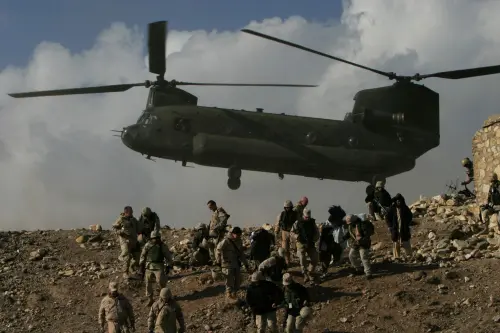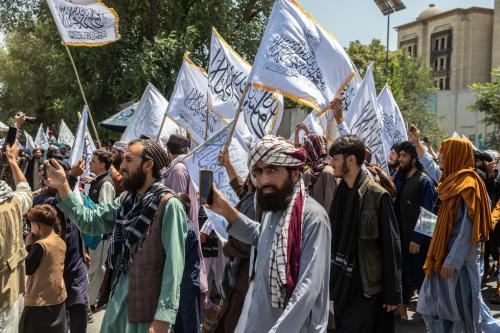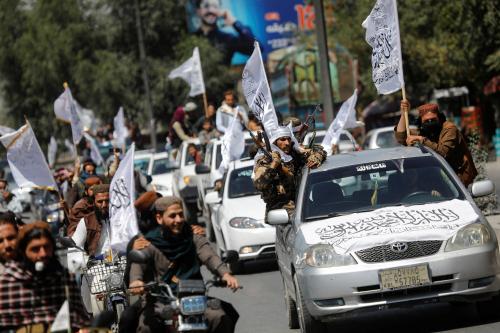There is probably no secret recipe for victory in Afghanistan, and President Trump was dealt a tough hand there, write John Allen and Michael O’Hanlon. Amid trying circumstances, with no great policy options available to him, they commend Trump for making a difficult and very presidential decision about future American policy. This piece originally appeared in USA Today.
There is probably no secret recipe for victory in Afghanistan—at least no such recipe that any American can concoct. President Trump was dealt a tough hand in Afghanistan. And as his predecessors (and many of us in the strategic community) have also learned, the United States enjoys only limited influence in this crucial part of the world. U.S. policy is about improving the odds of success—or at least reducing the odds of failure—at this point, not about ensuring any given outcome. In these trying circumstances, with no great policy options available to him, we would especially commend Mr. Trump for making a difficult and very presidential decision about future American policy.
We would distill the main goal of U.S. policy for the next three years to be this: Help the Afghan government reverse the momentum of the war. Several years ago, the Afghan government controlled more than 70 percent of the country. Now, according to U.S. intelligence, that figure is down to more like 60 percent, and the Taliban believe they are winning. If we can help the government move back towards 70 percent control, that may not mean victory for the Afghan government—but it will deprive the insurgency and its supports of the narrative that victory will soon be theirs. At a minimum, such an achievement would help ensure we can hold onto bases needed to monitor and attack extremists in South Asia. More hopefully, if accomplished, it might lead elements of the insurgency to conclude that the fight is no longer worth the effort, and pieces of it may split off and reconcile with Kabul.
In this context, a U.S. policy that does the following is probably the best we can hope for:
- Increase U.S. troops by up to several thousand, so that the total is still far less than the 100,000 GIs we deployed in the peak years of 2010-2011, but more than the current 8,500 or so. This would return us to the phase of the operation that President Obama elected to skip, back in 2014-2015, when he felt (understandably, but in our view mistakenly) that hastening our departure would light a fire under the Afghans and get them to do more.
- Use some of those added troops to mentor and advise Afghan units in the field, and to call in U.S. airstrikes more promptly and effectively when opportunities arise to strike hard at the Taliban. These American advisors and airpower controllers would be deployed in groups of typically 15 to 25—not with every Afghan unit, but with those needing help the most, perhaps because they have a new commander.
- When one combines up to several dozen of these field advisory teams with the quick reaction forces needed to go help them if they get into serious trouble, at least 2,000 and perhaps 3,000 to 4,000 additional American/NATO troops could be required. Thus the expected numbers.
- Of course, no strategy can be based just on troop numbers—a point that Secretary of Defense Jim Mattis has made throughout the process, and which General H.R. McMaster also understands very well. Thus, as one key additional priority, we must help the Afghan government continue to fight corruption. Encouragingly, there has been some progress of late, as the generally tough-nosed Special Inspector General for Afghanistan Reconstruction documents in a January report. It is also important, among other things, that Afghanistan hold parliamentary elections scheduled for 2018 and presidential elections in 2019 with punctuality and fairness and a reformed election oversight process.
- Wield both bigger carrots and bigger sticks with Pakistan. Pakistan has been a real “frenemy” in this war, helping us with logistics but also supporting the Afghan Taliban in their sanctuaries on Pakistani soil. This behavior has been duplicitous, even lethal to our forces at times. That said, it is partially understandable (even if not justifiable), given that Pakistan was left holding the bag after it helped us defeat the Soviets in Afghanistan in the 1980s and we then got up and left. Chaos in Afghanistan, with huge spillover effects into Pakistan, ensued. Islamabad still resents it and still partly mistrusts us as a result.
- Given this history, while we need to hold Pakistan accountable for its actions and respond proportionately, we need also to hold the door open to better relations someday. Reductions in aid, and more strikes by American or Afghan forces over the Pakistani border against the Taliban, are reasonable places to start. Targeted sanctions on those individuals in the Pakistani “ISI” intelligence forces who are known to help the Taliban could also be part of the mix. But a restoration of aid and perhaps even a free-trade zone could be offered to Pakistan if and when their cooperation improves.
- Try to mediate between India and Pakistan whenever and however possible—the latter’s resentments about India, including its presence in Afghanistan, make it harder for Pakistan to give up its support for the Taliban (Pakistan sees the Taliban partly as a hedge against long-term Indian domination of Afghanistan, however unlikely that latter prospect may seem to us).
Most of all, we should stay resolute. However alluring the idea of a clear exit strategy may be, it isn’t now available to us in this war. We need to avoid giving the Taliban and others reason to hope, or believe, that our presence will be ended before the job is done. If we need to mini-surge by a few thousand troops now, and then stay with a more modest presence through much of the 2020s, that is preferable to seeing another sanctuary for ISIS or al Qaeda develop on the eastern flank of the broader Middle East region.
This mission may have to outlast yet another American president. Trump needn’t promise us otherwise. If we are successful in helping defeat extremists and protect the American homeland with a small presence in Afghanistan for years to come, that is still success.
The Brookings Institution is committed to quality, independence, and impact.
We are supported by a diverse array of funders. In line with our values and policies, each Brookings publication represents the sole views of its author(s).







Commentary
Trump made the right move on Afghanistan
August 23, 2017